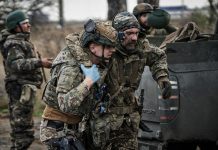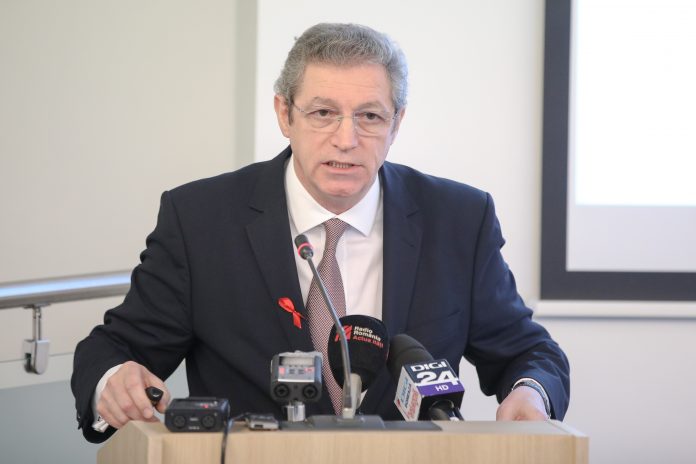It is 30 years since the fall of the regime of Nicolae Ceausescu. It’s also 30 years since most Romanians learned that AIDS affected not only ‘the rotten capitalist system’ but also on the ‘paradisiacal’ communist regime. It’s also 30 years since we discovered that many children in Romania were infected with the HIV virus. It’s 30 years since the world found out that Romania has a serious public health issue.
Prof. dr. Adrian Streinu Cercel was invited to take part in a debate at Universul.net moderated by Dan Turturică, to find out how and when AIDS was discovered in our country, how effective the state response was in treating patients and preventing further HIV infection, but more importantly, what steps should be taken in the future to finally close this dark chapter in our history.
Dan Turturică: When did you first find out about the existence of AIDS in Romania?
Adrian Streinu Cercel: We found out first in 1985, five years before the Revolution. We then recorded the first two cases of adults with the HIV virus in Romania, and there was very good cooperation between professor Berceanu from Hematology – Fundeni and Professor Căruntu, my boss at the time, from the Colentinta Hospital of Infectious diseases and so we were able to make a diagnosis,
The first case was a train conductor on the Bucharest-Vienna route who was a member of a sexual minority, and the second case was recorded just 2-3 months later; a doctor who had traveled from the U.S. also from a sexual minority.
This data was published in the “Medical life” magazine at the time. We were given permission to publish it and we really had open debates on the issue of AIDS-HIV in Romania.
The problem which appeared in Romania was the infected children in the orphanages. My colleagues and I believe this was an ‘epidemiological accident.’ Nobody went there to deliberately contaminate those children with a syringe. There were a series of health policies considered standard upon the time. For instance, if somebody got infected with Hepatitis A, everyone around (that person) was given immunoglobulin for protection. You were protected from Hepatitis A, but you also ran the risk of getting infected with something else.
How were the children from the orphanages in Romania infected with HIV?
Dan Turturică: Was it a contamination with infected blood?
Adrian Streinu Cercel: It was (what is called) an epidemiological accident. Nobody went there to do it on purpose. In August 1989, there was widescale testing within the orphanages and we found out that many children were infected with HIV.
Dan Turturică: When did you first notice the existence of this huge problem?
Adrian Streinu Cercel: Starting in 1985, after we had the first diagnoses, we set up the first national progrm against AIDS. Before 1990, cases had been reported to the World Health Organization. There were meetings to analyze cases of infant mortality. Between 1985 and 1989 we discovered a rise in infant mortality, but without determining the cause for this.
Dan Turturică: The cause hadn’t been established ?
Adrian Streinu Cercel: No. We had an idea that something was happening and we had to identify the agent which was provoking such things.
Dan Turturică: But the fact that many children from the orphanages were dying didn’t give rise to any suspicion?
Adrian Streinu Cercel: Of course, and this was on our agenda and we kept on discussing this infant mortality. We, from the infectious diseases department, were called to state our opinion on what could it be, because in the end those children were dying with sepsis – severe systemic infection. Now we know, but at that time we didn’t have an explanation. Data was gathered and in 1989 the Health Ministry made an assessment which shocked all the medical personnel. After the moment of 1989, in February- March 1990, we admitted 126 children with severe protein-calorie malnutrition at the Hospital of Infectious Diseases. They were just skin and bones and were infected with HIV. That was the moment when this issue entered the public agenda and everybody found out about it.
The Romanian State managed to save 60% of the HIV infected children at that time
Dan Turturică: From the testimonies of the people who faced this phenomenon at that time I remember two of them which still make me shiver, even today. One of them says: “Even if there were 100 children over there, you couldn’t hear any noise in the hospital except our steps when moving from one bed to another.” This is what Michael Carroll – an American photographer, who took photos of the children said. And there’s also the testimony of a doctor from Constanța, specialized in infectious diseases, Rodica Matusa: “Imagine how it is to see a dying child in a hospital bed, who realizes he will die, and it’s night time, and around him there are other four children holding candles.” Have you ever had such experiences?
Adrian Streinu Cercel: Absolutely. During the 90s we did not have any tools. We were working without gloves, those glass syringes which we were using over and over again… but there wasn’t any risk as that virus dies at about 65 degrees. Sterilization is performed at 120 degrees. With classical sterilization there wasn’t any problem.
The things were complicated, we were only just entering the domain of HIV pathology and we could barely understand, at a global level, how this virus is transmitted and what preventive measures should we implement.
Then, I wrote the universal preventive measures for the hospitals for the first time. Doctor Petrea from the Infectious Diseases Hospital – Colentina (the current Institute of Infectious diseases – “Matei Bals”) wrote the first paper about universal preventive measures and implementation rules.
We know that we have quite a large number of children born at that time (HIV infected) that are still alive – over 60% of them.
Dan Turturică: In numbers, how many infected children are we talking about?
Adrian Streinu Cercel: For the moment we are speaking about 14,000, of which more than 12,500 are under treatment, the rest of them are refusing therapy. Summing it up,we can talk about 24,000 cases including the deceased ones – since 1985. About 10,000 have died.
The Romanian doctors were determined to fix this problem. We went abroad and discussed with the pharmaceutical companies of the time to come and register in Romania.
After 1995, Romania, together with other states, signed the Paris Declaration, a very important one in which it recognized there was a problem, and that the HIV-AIDs was a major public health challenge,
Dan Turturică: But why did it take 5 years?
Adrian Streinu Cercel: Well, if you think that from 1982, when we had the first description of the virus, until 1995, when the countries around the world mobilized, this is quite a long time. Nobody was prepared for such a thing. It was a political step. This political step opened many doors and horizons. Without this political step we couldn’t have achieved anything. Every country would have been on its own.
”Why, do we still speak nowadays about discrimination of the HIV infected people?”
Dan Turturică: Did Romania sign that Declaration when it was proposed, and not later?
Adrian Streinu Cercel: Of course. When it was laid out, Romania signed it. We acknowledged it was a major public health problem and we had to do something. But 2 years passed until we set up a national Committee against AIDS in the Health Ministry and another inter-ministerial one. In the inter-ministerial committee, every state secretary from every important Ministry was given a precise task to fix a problem: the social issue, the integration issue, the medical problem, and the education one. Later, these committees were phased out, but they did a very good job.
That is why we can speak now, 30 years after the Revolution, about the fact that 60% of this unit has been preserved- this is a great achievement. In thus unit, we have doctors, architects, engineers, high school graduates, and of course people with less education. But, overall, it was a medical, social and educational success.
The starting point was a horrible one, as we had no idea what we were facing. We were fumbling in the dark and everybody was afraid of getting contaminated. This happens when you don’t know what you are up against. We, the doctors from the Infectious diseases in Bucharest and all the regional centers got directly involved and put fear aside. We said: we are doctors, we take the risk.
There was no discussion about stigmatization back then. I am a bit confused now, because we talk about a chronic infection, and if you take one pill a day you may have no problem, and you can lead a normal life, like every person who isn’t contaminated. Why do we still speak about discrimination? I mean in the context in which these people are normal.
We have to understand that we have in and on us ten times more micro-organisms, other than our own human cells. Therefore, we are somehow covered with micro-organisms; we are not sterile – micro-biologically speaking. If we were, we would have a problem. The micro-organisms actually protect us, they keep us alive.
HIV does not represent a problem from this point of view, so discrimination should disappear! Starting from yesterday!
Education – the next step in the fight against HIV-AIDS
Dan Turturică: Recently the results of a study about the perception within population from many countries in Europe regarding HIV have been disclosed and the figures are not so good for Romania. For instance, 5 out of 6 Romanians still believe that if somebody in their family would have HIV he would pose a danger for them. About 26% of the Romanians don’t know that AIDS represents a disease which appears at a later stage of HIV infection. About a third of them believe that the HIV virus could be contracted if they use the same toothbrush as an infected person, while 20% of them still believe it can be transmitted through kissing.
Adrian Streinu Cercel: These problems appear all over the world. As long as the information level is not good enough and data transmitted is not good quality, we find ourselves facing these interpretations.
We carried out a study in Romania using a Norwegian program. The results left us speechless. For instance, many people had no idea that the virus can be transmitted through blood or blood products. The problem lies in the blood, blood products, piercings, tattoos, and every invasive maneuver and exceeds the defense mechanisms of the body.
Nobody ever speaks about unprotected sexual contact. Any occasional sexual contact should be protected with a condom. It is as if the condoms have disappeared. I’ve seen on TV they are trying to renew the issue of condoms into a humorous style. This is a good idea, because we have to remember the simple things: if we don’t protect ourselves, nobody else will.
We have now a legal framework stating that the HIV infected patient is obliged to inform his or her sexual partner, otherwise he may be guilty if transmitting the disease on purpose. But there is no personal gain if that person goes to jail?
The time has come for this program (the fight against HIV-AIDS) when we have to change the paradigm. So far, we have concentrated on the medical issue, the social one. Now we have to strongly stress the educational aspect. People should understand that health education is not optional. It has to become mandatory. Everyone should be informed and aware of their actions.
We are now speaking about HIV, tomorrow we’ll speak about another micro-organism transmitted sexually or in another way. On Earth there are over 3 billion micro-organisms. And out of these 3 billion, we know about less than 0.5% of them.
Dan Turturică: You mentioned that we should concentrate on education. How and who should take responsibility for leading this paradigm change?
Adrian Streinu Cercel: We have at least two important actors. The first and most important one is the Ministry of Education which should develop educational programs ven in the early school years. The educational system in the U.S., do you see how much sport they practise? We, too, should adopt a more healthy way of living. It is known that education through sport brings health education. But as long as at a governmental level, sport is considered optional, we’ll remain in the same situation. A person lacking education and information is exposed to risk.
One single pill a day ensures a normal life for HIV patients
Dan Turturică: The sport training is somehow indirect support. How about a direct type of training, for instance, the classes of sexual education in schools? Could they be the answer?
Adrian Streinu Cercel: Definitely so, but they have to be supported. It has to be like the Chinese drop. The same information introduced periodically, will inevitably be memorized.
We were talking about actors. The second one is the Health Ministry, which has the opportunity to introduce within the frame-contract a free testing with the family doctor to detect the HIV virus. Two years ago we introduced testing for the Hepatic viruses B and C. This year we can include one for HIV too. What were the results? In Romania, since we began testing, the Hepatitis C is cured in about 99.32% cases.
Currently for the Hepatitis B we introduced therapy and the patient becomes undetectable and so he will not transmit the virus. So, they won’t go on to develop chronic liver disease, liver cirrhosis, and liver cancer.
For HIV we posses medication – one pill a day and the patient becomes undetectable. Undetectable = non-transferable. On the one hand this means they can live a normal life; on the other hand they stop the virus transmission.
Dan Turturică: How many pills those who were trying to keep the disease under control used to take during the ‘90s? You say now we have come to one single pill.
Adrian Streinu Cercel: In 1996, we started with 6 pills: 2 in the morning, 2 at noon, and 2 in the evening. Initially there had been the famous AZT, and after that ddC, and then inhibitors, etc. We had the opportunity to access these medicines and the result is visible with the large number of infected patients we have managed to save over the last 30 years.
Dan Turturică: However, you said that a large number of infected patients refuse the treatment.
Adrian Streinu Cercel: Yes, there are many people who refuse, because they haven’t got used to the idea. The first reaction when a patient receives the test results and discovers they are infected with HIV is to deny it: “This can’t happen to me.” It’s a normal reaction. The respective person goes through an enormous emotional stress no matter which disease he has. The people become more restrained and if you don’t keep calling them, then they cut themselves off. There are psychologists at infectious diseases hospitals, who may help the patients. And therapy is now a piece of cake and paid for by the state.
Dan Turturică: How many people refuse the treatment? Are we speaking about several thousand?
Adrian Streinu Cercel: About one thousand or so. Some of them are commuting. That is between Romania, Spain, Great Britain, Germany, France and Greece. It is like a pool of patients traveling here and there. Some of them go to the respective areas and buy the medicines without declaring in Romania, to be recorded. Therefore, it is possible that many of them are under treatment and the number is not as large as I have stated, but this is the official data.
What should we do now? We belong to the European Union. The EU has to issue a platform where HIV infected patients can find a clinic suitable for his treatment no matter which country they live in. The medicine should cost the same. For the time being, that’s not the case. In Romania the prices are very low. And this is good, but taking into account the intense circulation of the people, Romania is no longer Romania per se. And if we want to take care of our patients, we have to establish cooperation with the other member states of the European Union.
What is the meaning of 90-90-90 within HIV-AIDS prevention and why HIV testing should become mandatory?
Dan Turturică: People speak much about the targets 90-90-90. Can you explain the meaning of this?
Adrian Streinu Cercel: That means we have to detect 90% of them, 90% of those detected should get treatment and 90% of the ones on treatment should become undetectable. Undetectable= non-transmissible. The targets seem to be OK statistically speaking, as well as epidemiologically, and that’s why I have proposed and still insist on the idea that every person on Romanian territory should be HIV tested, and tested for Hepatitis B and C. We have a huge opportunity in Romania to keep these three viruses under control.
Dan Turturică: How could mandatory HIV testing could be introduced? For the time being it’s mandatory only for the people who want to get married.
Adrian Streinu Cercel: In 1998 we issued a ministerial order where we stated: the following categories of personnel must be tested free of charge. And these are: pregnant women, in the first and last quarter of pregnancy, long-haul drivers, people who spend more than six months abroad, long-distance sailors, blood donors, etc. The fact that we monitored these categories and intervened epidemiologically, meant Romania stayed at a level of 0.0014% HIV incidence within its population. Take a look at France or Germany for instance, what are their levels? Much higher. We remained at a low level. Ukraine has also a very serious problem, as does Poland. They have only recently begun radical intervention.
Dan Turturică: How should this leap from the testing introduced in 1989 to the mandatory one happen?
Adrian Streinu Cercel: Well, it’s quite simple: it has to be introduced on the simple grid of testing, when you come to the doctor, no matter if the GP or at the hospital – the standard procedure. You see, there is a frame contract which stipulates what kind of tests should be done for free on a base level. HIV testing should be introduced on the basic list and the problem is solved.
Dan Turturică: Is it such a high cost for the Romanian state?
Adrian Streinu Cercel: We speak about 17 lei (less than 4 euros).
What is and how does the HIV test found in the pharmacies work?
Dan Turturică: Besides introducing mandatory testing, what else could the Romanian state put in place?
Adrian Streinu Cercel: To promote the ambulatory testing. There is a series of quick tests that you can find in the pharmacy. Every person who is aware of having done something „different” can buy such a test, which is a bit more expensive, and can test himself at home. If one line appears this is a negative answer, if there are two lines the result is positive – just like the pregnancy test. You perform a puncture in the finger and apply a drop of blood. The test is very simple.
If the result is positive he will go to the doctor and will be directed to the specific branch. Nowadays a HIV infected patient can lead a normal life in society, within a family without any kind of problems, just with a pill a day, for the rest of his life. There is no risk of getting sick from AIDS.
We are now focused on the idea of functional healing. That is we perform some international clinical trials, through which we test a series of molecules capable to inhibit this virus for a long period of time. For instance, there is an implant which could be done now which has been tested which provides protection for a year without being necessary to take pills.
Dan Turturică: The U.S. recently announced a very ambitious plan: they propose to lower cases of HIV transmission for the next 5 years by 75% and by 90% in the next 10 years. Does Romania have such a target?
Adrian Streinu Cercel: Of course. Romania set up this target that you are speaking about in 2001. In 2001, Romania attended the meeting of the UN General Assembly, on the HIV issue. By then, Romania set up this target declaring that it would provide free access to the HIV-AIDS program. It was the first country in the world to do it in real terms.
I presented in 2002, in Geneva, the idea that undetectable= non-transmissible and I proposed to use the therapy as prevention of mass transmission of the HIV virus. At that time I was told:”It’s not affordable.” Ten years later, at the Washington DC Congress, Mrs. Clinton said:”Therapy as prevention.”
Romania was a promoter and that’s why the Romanian program was well received worldwide and was also promoted within other countries. We stated from the very beginning these targets. By way of proof, we have remained at the level of 0.0014% (HIV incidence upon population).
Dan Turturică: You mentioned before about this HIV test that everyone can purchase from the pharmacy. Is it the state involved here or should it be?
Adrian Streinu Cercel: The state can promote it. If the public health authority doesn’t speak about this opportunity, then the people will remain more or less ignorant.
Undetectable = non-transmissible
Dan Turturică: 6 out of 10 Romanians wouldn’t feel happy working with a HIV infected person, 7 out of 10 believe that the HIV infected persons shouldn’t be allowed to do any job. How can these perceptions be changed?
Adrian Streinu Cercel: The answer is very simple: undetectable= non transmissible. I don’t have a virus in my blood; therefore I have nothing to transmit. It is so simple. We just have to repeat this message.
People are worried for nothing. We have no idea who do we sit at a table with, who do we meet, who do we shake hands with or who do we do other things with. The rule has to be: I protect myself to protect you.
Dan Turturică: Which would be the five measures we should implement so as to bring the HIV program to the next level?
Adrian Streinu Cercel: We have the following elements: the first one is to introduce the testing within the GP, free of charge. The second one would be to reinforce the counseling system before and after testing, as the people need a psychological support. For the patient to be undetectable we have to persuade him into going under treatment, and here the psychologist is important. Three – education. The educational system for health reasons, starting today. It is unacceptable to speak about stigma for HIV, when the person is absolutely normal and even more, when the virus is undetectable and cannot be transmitted.
The Church has also has a very important role. Here we can add the ministry of culture and religious affairs, the ministry of labor, social assistance, and many others…. That’s why that committee (the inter-ministerial commission set up in the ’90, which tackled the HIV issue) that I mentioned earlier has done some very good things and the results are visible today.
We should set up such committees for other major public health problems as well. We talk about HIV for the time being, but we can talk about cervical cancer for which we possess a very good means of prevention through vaccination. Australia has just stated they want to eradicate the issue of cervical cancer in no more than 20 years, as they have a vaccination coverage rate of 80% for boys and girls.




















